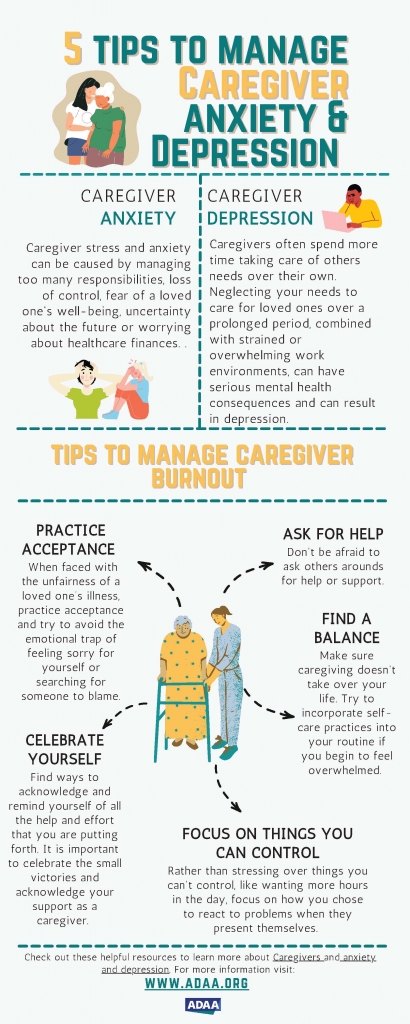5 Tips to Manage Caregiver Anxiety and Depression
Caring for a loved one with a chronic illness can be stressful – physically, emotionally, and financially – and burnout among caregivers can be extremely high. Ruth Lippin, LCSW, JD, sees the deleterious effects of caregiver burnout all too often in her therapy practice in New York City. Anxiety and stress among caregivers, she says, exploded during the COVID-19 pandemic and continues, in part, due to aging among the baby boomer population.
“I counsel clients who are living with the behavioral health effects of old age, injury or illness, and in many situations, I am just as or even more concerned with the mental health of their caregivers,” Lippin says. “Whether due to financial barriers or feelings of guilt, caregivers often do not adequately take care of themselves, which can take a significant toll on their mental and physical health.”
According to Lippin, caregiver stress and anxiety can also transfer to the loved one they are caring for – a phenomenon that in its extreme, may lead to abuse of or substandard care for the person needing care.
“Unpaid, family caregivers can only be stretched to a point before breaking,” she says. “Eventually, they can become resentful and angry. Without proper acknowledgement of and treatment for these issues, they in turn may become depressed, anxious, short, angry, or even aggressive with their loved one.”
Anxiety & Depression Association of America Offers Support and Resources
Lippin is a member of the Anxiety & Depression Association of America (ADAA), an international non-profit organization dedicated to the prevention, treatment, and cure of anxiety, depression, OCD, PSTD, and co-occurring disorders through the alignment of science, treatment, and education.
While ADAA is a professional organization of members working in the mental health field, it also offers support and resources to the general population, including family caregivers of aging or ill loved ones. Caregivers can discover many of these resources on ADAA’s Caregivers web page, which includes tips on when a caregiver should seek care for themselves, organizations from whom caregivers can access support, and a link to ADAA’s online peer-to-peer communities through which caregivers can connect with others, contribute to ongoing conversations, or start their own conversation with a question or post about their journey.
Take a look at one of ADAA’s resources below, “5 Tips to Manage Caregiver Anxiety & Depression,” then read on for more insight and advice from Ruth Lippin:

5 Tips to Manage Caregiver Anxiety & Depression
Caregiver Anxiety
Caregiver stress and anxiety can be caused by managing too many responsibilities, loos of control, fear of a loved one’s well-being, uncertainty about the future or worrying about healthcare finances.
Caregiver Depression
Caregivers often spend more time taking care of others needs over their own. Neglecting your needs to care for a loved ones over a prolonged period, combined with strained or overwhelming work environments, can have serious mental health consequences and can result in depression.
Tips to Manage Caregiver Burnout
Practice Acceptance
When faced with the unfairness of a loved one’s illness, practice acceptance and try to avoid the emotional trap of feeling sorry for yourself or searching for someone to blame.
Celebrate Yourself
Find ways to acknowledge and remind yourself of all the help and effort that you are putting forth. It is important to celebrate the small victories and acknowledge your support as a caregiver.
Ask for Help
Don’t be afraid to ask others around for help and support.
Find a Balance
Make sure caregiving doesn’t take over your life. Try to incorporate self-care practices into your routine if you begin to fell overwhelmed.
Focus on the Things You Can Control
Rather than stressing over things you can’t control like wanting more hours in the day, focus on how you chose to react to problems when they present themselves.
Check out these helpful resources to learn more about caregivers, and anxiety and depression. For more information visit www.adaa.org.
Caregivers: Ask for Help
As illustrated above, one tip for managing caregiver burnout is to ask for help – an approach Lippin wholeheartedly endorses.
“The old proverb ‘it takes a village to raise a child’ applies to caregiving for our older adults and chronically ill loved ones as well,” Lippin says. “However, in today’s isolated society, that ‘village’ can be difficult to find or create.”
While Lippin encourages the use of formal, paid caregivers to provide respite care and alleviate pressure on overburdened caregivers, she acknowledges that financial barriers prevent many from being able to afford professional help. In addition, she cautions that for people with generalized anxiety disorder (GAD), using formal, paid caregivers can create additional stress.
“Family caregivers with GAD– known colloquially as “worriers” – may be concerned about how their loved one will be treated, or that something bad will happen, on the paid caregiver’s watch,” she says. “The reality is that bad things can happen at any time, under anyone’s watch. By teaching my clients the skills they need to tolerate the anxious feelings these thoughts provoke they can utilize formal caregivers. This is a game changer for both the caregiver and the person being cared for.”
Contact a Mental Health Provider
ADAA suggests caregivers consult their doctor or contact a mental health provider if they experience any signs or symptoms of a mental health condition, especially if symptoms persist for two or more consecutive weeks and affect their quality of life.
“Some telltale signs that it may be time to seek help from therapist are not sleeping well, irritability, loss of appetite – or conversely, overeating – not paying attention to your own personal hygiene, excessive anger or sadness, or losing control of your emotions,” Lippin says.
Lippin’s preferred approach for treating anxiety and depression is cognitive behavioral therapy (CBT), a structured, goal-oriented type of therapy that focuses on identifying, understanding and subsequently modifying thoughts and behaviors. CBT is a short-term treatment modality that helps one build the skills they need for long-term success.
“CBT can help caregivers balance automatic, negative thoughts with more realistic ways of looking at a situation,” Lippin says. “It allows them to think differently about caregiving and figure out strategies for taking care of themselves as well as their loved one, whether it’s hiring a professional caregiver to provide respite care or taking 30 minutes for a quick nap, a walk outside, or a silly TV show.”
“Caregivers face an objectively hard situation,” she adds. “They should be allowed the time and space to take care of themselves without feeling guilty. I would counsel them to practice self-compassion for their limitations and seek comfort in a way that works for them.”


















